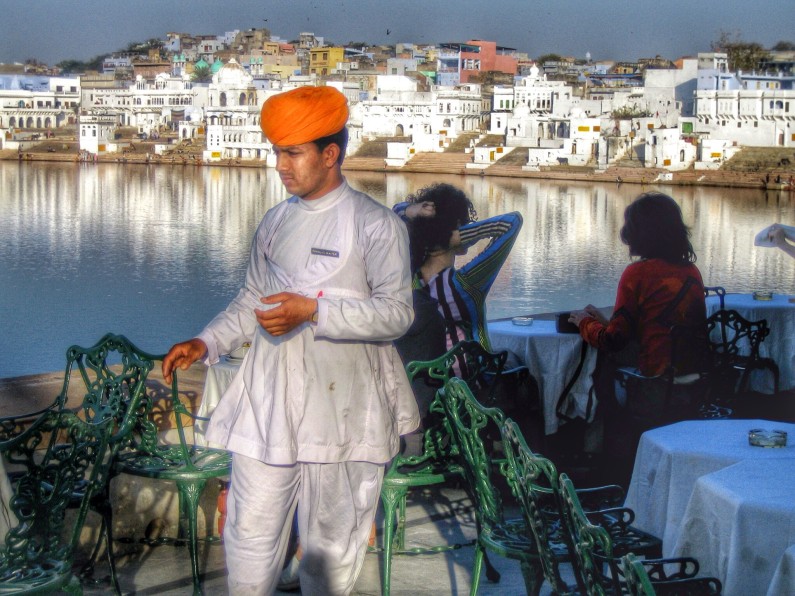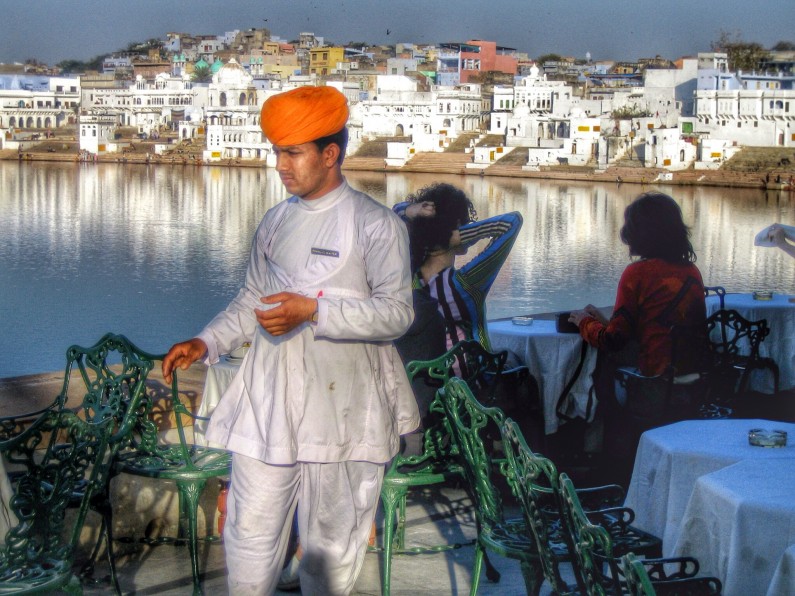

Rajasthan is India’s most colorful, historical, and multi-layered state. Each encounter with its peoples and culture uncovers more depth, particularly in its vast folkloric traditions. Cultural performances portray historical events, religious beliefs, and musical heritage, illuminating trials and tribulations of the hardscrabble desert life, juxtaposed against opulent palaces. They echo the call to war, the cry of the peacock, the swirl of the sands, and the thunderstorms, longed for in this parched land.
Whether in an auditorium, the open-air, sitting on the ground in rustic surroundings, they are impactful: vibrant dress and ornaments, rhythmic, gyrating hands and feet, wail of string accompaniments, percussion of drums and chanting of songs. Professional tribal performers each have a distinctive style. Audiences participate enthusiastically in the performances of these wandering minstrels and traveling entertainers.Jogis of Mewat are known for recitation of the ballads of history and daily lifestyle.
Chipas or Joshis are famous for creating elaborately painted works of art known as “Phad”, a scroll detailing highlights of the life and heroic deeds of Pabuji Ramdeo, a 14thC folk hero. Villagers invite Bhopa performers during sickness and misfortune. Ballad are sung they play a stringed instrument, lamps reveal relevant portions at appropriate points. Dance is found in almost limitless variations in Rajasthan. Unsophisticated forms are seen at fairs and festivals and on religious, auspicious or social occasions.
Bhavai, a ritual offering to Goddess Amba, displays skilled balance as the veiled danseuse gracefully follows the beat with numerous brass pitchers on her head, while perched on the edge of a glass or open sword. Chari involves dancing with a chari, or pot containing a lighted lamp, on one’s head. Dancers choreograph deft patterns with their hands, creating streaming, illuminated patterns. Drum Dance is performed by five men with huge drums round their necks, banging cymbals, accompanying a dancer who holds a naked sword in his mouth, vigorously twirling three painted sticks.
Fire Dance by the Jasnathi tribe displays tantric powers. Men leap through burning embers to a crescendo of drumbeats, inducing a hypnotic, trance-like state, showcasing unshakeable faith in the gods. Gair, a gyrating, Holi festival dance performed originally by Bhil men, wearing long, pleated tunics that flare out into full-length skirts, using sticks to create the rhythm. The Gair Ghoomar is among the few where men and women dance together. Gangaur is performed to appease the Goddess Parvati, wife to Lord Shiva, to ensure marital bliss.
Ghoomar is staged traditionally on auspicious occasions by and for women. Derived from the word ghoomna, (pirouette), the ladies move gently, in circles, their faces shadowed by veils. The intricately embroidered, colorful skirts flare and subside, in slow motion. It is a ritual dance at weddings, a welcome to the bride from her new family. Kachhi Ghodi: elaborately costumed men “ride” caparisoned dummy horses, to ballads narrating the exploits of bandits. A vigorous dance, with mock-fights, nimble sidestepping and pirouetting to the music of fifes and drums, it is performed for the entertainment of a bridegroom’s party.
Kalbeliya: this sinuous dance is a hallmark of the Snake-charmer’s community. The long, black skirts embroidered with silver ribbons, represent serpentine scales. Spinning and swaying, the performers twine and coil in a boneless fashion to an escalating, breath-taking tempo. Raas is a reenactment of Sri Krishna’s dances with the Gopis (maidens), symbolic of human love of the Divine.
Terah Taali -The Kamad community performs this unusual, devotional dance in honor of their deity and folk-hero, Baba Ramdeo. The men play a four-stringed instrument called a chau-tara. The women, strung with dozens of manjeeras, or cymbals, tied on in thirteen (terah) spots all over their bodies, strike them with the ones they hold in their hands, performing intricate arabesques. Sitting before the image of the deity, they might also for dramatic effect, hold a sword between their teeth or place pots with lighted lamps on their heads.
The professionals, often in association with amateurs, have popularized folk opera. Gawari is a Bhil dance drama. Between the enactments of various episodes, the entire troupe dances around a central spot consecrated to a deity. Kathputli myths and legends are performed by skilled puppeteers. This is a family affair, with wives and children, all involved with erecting the stage, playing the dholak, or drum and singing the ballads.
The evocative music has absorbed the unique features of its adjoining states: Gujarat, Haryana and Punjab. A typical folk song begins with an alaap, (overture), which sets the theme, followed by the recital of the couplet called the dooba. The Panihari style belongs to women bringing water from distant wells singing in harmony. Depicting daily life centered on the water-well, songs tell about chance encounters with lovers, incorrigible mothers and sisters-in-law.
Maand is a unique style of song and melody, keeping true to its desert environment. This sophisticated music, in praise of the Rajput rulers has percolated down from the royal courts. It speaks of love, separation, chivalry and revelry. Folk music is also religious, the Mahabharat and Ramayan scriptures supplying popular themes. There is a great tradition of popular poetry, under rival banners. Group singing of classical bandishes (arrangements) is also unique to this genre.
Folkloric musical instruments fall within strings, wind, autophonic and percussion categories. Each group has innumerable varieties peculiar to their region and tribes.String combinations are mounted on bases and bellies of bamboo, dried coconuts or gourds, and stretched across wooden frets. Others incorporate large circular resonators emanating a stirring, deep reverberation. Fingers beat out the rhythm on the belly; often the bows are embellished with small bells (ghungroos) that provide a syncopated, tinkling undertone to the whole. Bowing is a skillful exercise.
The wind instruments have many variations of the flute; rudimentary artifacts, producing a powerful, eerie sound in dexterous hands. There are simple single tubes; the double pipes of the Algoza (one for the notes, one for the drone); the vertical Nad into which the player whistles, at the same time gurgling a song in his throat or singing intermittently. The effect is haunting. The Poongi has been made famous internationally through pictures of the ubiquitous snake-charmers; a staple of all tourist collateral on India.
Rajasthan also has a wide range of trumpets from the small Singi of the Jogi to the massive Karna and the intriguing looking Nagphani. Constructed of wood, bamboo, metal or other natural materials, the common man’s orchestra is composed of Dhol, Thati and Bankia. Auto phonic instruments are ritually accompanied by the blowing of conch shells and beating of drums at aartis (devotional rituals) and other religious or auspicious social occasions. Varieties of drums form the percussion group: two sided, single sided, shallow rimmed and single faced. The player strikes the center with his left hand and the edge of the membrane with a stick attached to a finger of the right hand.
Costumes and jewelry are essential components of the performance. In defiance of the stark desert surroundings, everything emanates vibrant colors, heavy embroidery, mirrored, or appliqued garments, and intricate, sumptuous jewelry – a rainbow patchwork of ancient arts, traditions and culture. Each form of dance has a specific costume. Most are flamboyant with extensive ornamentation and jewels. The costumes reflect climatic conditions, family and economic status. The popular traditional dresses and costumes include the Banda, Dhoti, Angrakhi, Achkan, Ghagras and Saris. The tradition of wearing bandhni, (tie-dye) stems from time immemorial.
The designs and mirror-work of swirling ghagras, lehengas and multi-colored dupattas (skirts and veils) of the ghoomar; the scintillating skirts of the Kalbeliya dancers attired in traditional black, paneled in silver, the highly caparisoned dummy horses of the Kachhi Ghodi performers, the ivory and lac bangles covering arms from wrist to shoulders of the Banjars; tassels suspended from wrists; bead woven necklaces and headgear; the leheriya (diagonal, contrasting waves of contrasting color) and turban of the musician. Males dress in frilled and embroidered ‘kurtas’ or jackets; or sport royal sherwanis up to the knees, personifying their royal heritage, completed by the impressive, colorful pagri (turban).
Rajasthani jewelry is intricate and magnificent. The state is one of the world’s largest centers for hand cutting of gems. It produces precious and semi-precious stones. Gold, silver and enameled jewelry from headbands to anklets is crafted in Rajasthan. Performers, plays, dances, music, instruments and costumes come together in a magical tapestry. No description, however graphic can do justice. One needs to be there, to immerse the senses in this experience of a lifetime.
Blog By Bina Joseph
Image courtesy of Nick Kenrick – Flickr License


